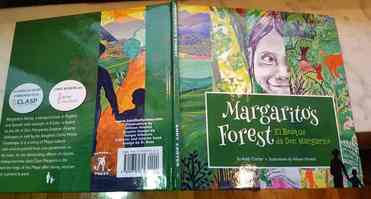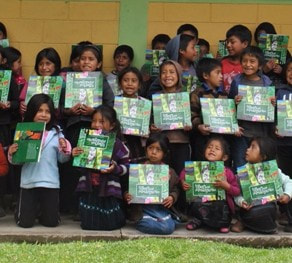
Maya Book Project Readies for Second Printing of El Bosque de Don Margarito
A generous grant from For a Better Tomorrow will enable the Maya Book Project to print an additional 3,000 of this Spanish/K’iche’ version of the book for distribution to schools in Guatemala. The process is being guided by the Steering Committee in Guatemala who began meeting this year. Their goal is to increase the book’s impact and guide its dissemination to teachers and students throughout the Quiche region of Guatemala. They are creating supplementary materials and lesson guides to support teachers who are using the book in their classrooms to teach students to read and write in K’iche’. Grants from Sisbro and the Pierce Family Foundation have supported this development process over the past year and will enable a series of workshops with teachers as part of the distribution process.
The translation of K’iche’ by Eduardo is wonderfully done. For many K’iche’ speaking communities, they never learned to write or read well in their own language, even for the teachers. This is a great resource for teaching K’iche’ to students. “Spanish is the language of our every day work and interactions, English is useful to know, but K’iche’ is the inheritance of our ancestors, it’s the language of the heart” -Eduardo Elias
Most schools have NO text books or resources to use in their classrooms. To have a book to use in their classes, and enough copies to pass out to students in the class is a huge resource for lesson plans. And this book can be utilized for a variety of subjects.
4.Being able to read a story in their own language, about their own neighbors, and stories from their own people is incredible.
The Steering Committee is:
*Allison Havens, Coordinator of Maya Book Project in Guatemala and illustrator for El Bosque de Don Margarito.
*Omar Mejia, a former high school and primary school teacher and the current Director of Acorn Childcare Center, in Quetzaltenango, Guatemala
*Eduardo Elias, a professional Spanish/K'iche' translator and a Spanish/K'iche' teacher at Proyecto Linguistico Quetzaltenango, in Quetzaltenango.
*Petrona López Pastor, Teacher and Director of Saq Ja’ Basico School
*Lázaro Reyes Sajbin, Teacher and Administrator of Saq Ja’ Basico School
A generous grant from For a Better Tomorrow will enable the Maya Book Project to print an additional 3,000 of this Spanish/K’iche’ version of the book for distribution to schools in Guatemala. The process is being guided by the Steering Committee in Guatemala who began meeting this year. Their goal is to increase the book’s impact and guide its dissemination to teachers and students throughout the Quiche region of Guatemala. They are creating supplementary materials and lesson guides to support teachers who are using the book in their classrooms to teach students to read and write in K’iche’. Grants from Sisbro and the Pierce Family Foundation have supported this development process over the past year and will enable a series of workshops with teachers as part of the distribution process.
The translation of K’iche’ by Eduardo is wonderfully done. For many K’iche’ speaking communities, they never learned to write or read well in their own language, even for the teachers. This is a great resource for teaching K’iche’ to students. “Spanish is the language of our every day work and interactions, English is useful to know, but K’iche’ is the inheritance of our ancestors, it’s the language of the heart” -Eduardo Elias
Most schools have NO text books or resources to use in their classrooms. To have a book to use in their classes, and enough copies to pass out to students in the class is a huge resource for lesson plans. And this book can be utilized for a variety of subjects.
4.Being able to read a story in their own language, about their own neighbors, and stories from their own people is incredible.
The Steering Committee is:
*Allison Havens, Coordinator of Maya Book Project in Guatemala and illustrator for El Bosque de Don Margarito.
*Omar Mejia, a former high school and primary school teacher and the current Director of Acorn Childcare Center, in Quetzaltenango, Guatemala
*Eduardo Elias, a professional Spanish/K'iche' translator and a Spanish/K'iche' teacher at Proyecto Linguistico Quetzaltenango, in Quetzaltenango.
*Petrona López Pastor, Teacher and Director of Saq Ja’ Basico School
*Lázaro Reyes Sajbin, Teacher and Administrator of Saq Ja’ Basico School

NOW available in a gorgeous hardcover edition, Margarito's Forest continues to dazzle children and grownups alike.
Price: $20.00
Named a Commended Title by CLASP (Consortium for Latin American Studies Programs) and a Best Book of 2017 by the Bank Street School of Education.
Price: $20.00
Named a Commended Title by CLASP (Consortium for Latin American Studies Programs) and a Best Book of 2017 by the Bank Street School of Education.
BUY MARGARITO'S FOREST HARDCOVER NOW
"As the devastating effects of climate change become clear, Don Margarito’s life and the ways of the Maya offer timely wisdom for a planet in peril."
|
|
Margarito’s Forest is a story of Maya culture and wisdom passed from one generation to the next. This beautifully illustrated bilingual book in English and Spanish, with excerpts in K’iche’, is based on María Guadalupe’s memories of her father, Don Margarito Esteban Álvarez Velázquez. It follows Don Margarito’s lifelong work of planting and nurturing trees after his village in Guatemala is chased from their ancestral land by a right wing military. The Maya carry their love for the forest with them, creating a beautiful forest in the mountains.
The lovely illustrations show Maya children learning to plant trees and to nurture them until the trees are tall and sturdy. The book can provide opportunities for a conversation with children about their own community and the impact of the heavy carbon footprint that is threatening ecosystems everywhere. There are helpful study questions for teachers, librarians and parents about Don Margarito and his village. The book also includes a brief explanation of the Maya numbering system, which is likely the first civilization to introduce the use of zero in counting. Children will learn how to count in K’iche’ and to compare their number system with our own Arabic system. |
BUY MARGARITO'S FOREST PAPERBACK NOW
STUDY QUESTIONS FOR MARGARITO’S FOREST
1. Dona’ Guadelupe told Esteban that caring for the land and respecting all of creation were the traditional ways of the Maya. She said she had learned these traditional ways from her father, Don Margarito. What are some important things that you have learned from your parents?
2. As a child Margarito liked to go exploring in the woodlands to find new and interesting plants and animals. Where do you like to go exploring? What discoveries have you made in these places?
3. Margarito’s questions about plants and animals led him to the village holy man, Don Calixto. When you have questions, where do you go to find answers?
4. Don Calixto taught Margarito how to count the days and follow the cycles of the earth in planting and harvesting. Why do you think the ancient Maya needed to count the days? How do you think the Maya learned to predict the cycles of the seasons? What in nature can you use to tell things about the seasons?
5. When the army came to destroy Dona’ Guadelupe’s village, she fled into the jungle with her two young children. But Don Margarito would not leave his land, and he was killed. Throughout history there have been people with the courage to die for what they believe. Can you think of any other people in history who have been willing to die for their beliefs?
6. When Dona’ Guadelupe fled into the jungle with her two young children, they survived by eating weeds and roots. How did she know which plants she could eat? Do you know any wild plants that you can eat?
7. People in the village laughed at Margarito for planting trees instead of planting more corn and beans. But he was not bothered by their teasing because he believed that his forest was important. Have you ever been teased or taunted by someone who did not agree with what you were doing?
8. When Dona’ Guadalupe and Esteban planted his seedling, they lit a candle to ask the Earth’s blessing. Lighting a candle when planting was a Maya ritual that Dona’ Guadelupe learned from her father. Does your family have any rituals?
9. The Mayan people held a deep love and respect for the land. If we adopted the Maya way, how would we live differently in our community?
10. Why is it important to plant and care for forests? What do they contribute to our lives or to the condition of planet earth? If you would like to learn more about trees you can go to this website:
http://extension.illinois.edu/trees1/16.html
Here is a fun scavenger hunt activity that you can do with your class:
http://ellenjmchenry.co/botany-scavenger-hunt/
1. Dona’ Guadelupe told Esteban that caring for the land and respecting all of creation were the traditional ways of the Maya. She said she had learned these traditional ways from her father, Don Margarito. What are some important things that you have learned from your parents?
2. As a child Margarito liked to go exploring in the woodlands to find new and interesting plants and animals. Where do you like to go exploring? What discoveries have you made in these places?
3. Margarito’s questions about plants and animals led him to the village holy man, Don Calixto. When you have questions, where do you go to find answers?
4. Don Calixto taught Margarito how to count the days and follow the cycles of the earth in planting and harvesting. Why do you think the ancient Maya needed to count the days? How do you think the Maya learned to predict the cycles of the seasons? What in nature can you use to tell things about the seasons?
5. When the army came to destroy Dona’ Guadelupe’s village, she fled into the jungle with her two young children. But Don Margarito would not leave his land, and he was killed. Throughout history there have been people with the courage to die for what they believe. Can you think of any other people in history who have been willing to die for their beliefs?
6. When Dona’ Guadelupe fled into the jungle with her two young children, they survived by eating weeds and roots. How did she know which plants she could eat? Do you know any wild plants that you can eat?
7. People in the village laughed at Margarito for planting trees instead of planting more corn and beans. But he was not bothered by their teasing because he believed that his forest was important. Have you ever been teased or taunted by someone who did not agree with what you were doing?
8. When Dona’ Guadalupe and Esteban planted his seedling, they lit a candle to ask the Earth’s blessing. Lighting a candle when planting was a Maya ritual that Dona’ Guadelupe learned from her father. Does your family have any rituals?
9. The Mayan people held a deep love and respect for the land. If we adopted the Maya way, how would we live differently in our community?
10. Why is it important to plant and care for forests? What do they contribute to our lives or to the condition of planet earth? If you would like to learn more about trees you can go to this website:
http://extension.illinois.edu/trees1/16.html
Here is a fun scavenger hunt activity that you can do with your class:
http://ellenjmchenry.co/botany-scavenger-hunt/




